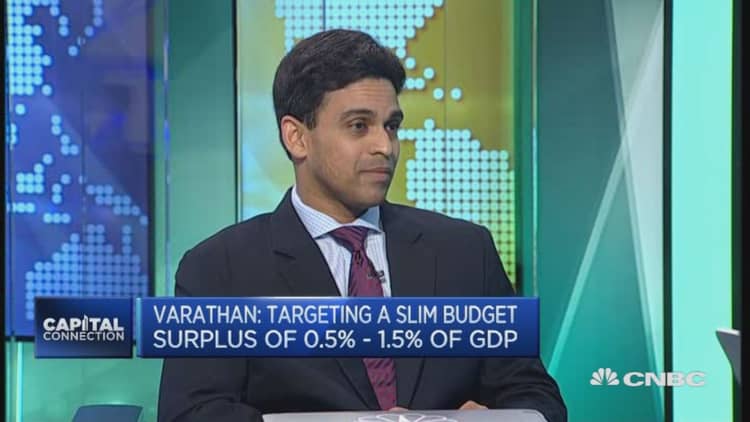Singapore's expanded fiscal program, unveiled in Thursday's 2016-2017 budget, may see the central bank hold off on monetary stimulus at its April meeting even as the economy flirts with technical recession.
The government will spend $53 billion for the fiscal year starting April 1, a 7.3 percent rise from the previous year and well above consensus expectations, bringing the overall budget surplus to $2.5 billion, Finance Minister Heng Swee Kiat announced on Thursday.
The bulk of funds are directed at supporting businesses, especially small and medium sized enterprises (SMEs), with measures including higher corporate income tax rebates. Meanwhile, higher levies on foreign workers—monthly fees local businesses pay for each foreign worker—will be deferred for certain struggling industries, such as the marine sector. Investment in public infrastructure projects will also increase, said Heng.
This fiscal package provides the Monetary of Singapore (MAS), the island-nation's central bank, with leeway to keep monetary policy steady even as many regional central banks are looking to ease, economists said.
"A contractionary fiscal policy stance, while not our base case, would have raised the probability of an exchange rate policy easing move by the MAS in April. These risks did not materialize," said Michael Wan, economist at Credit Suisse, in a note.

"Our base case continues to be for the MAS to remain on hold in April, with the central bank still publicly setting a rather high bar to further exchange rate policy easing."
Instead of interest rates, the MAS manages monetary policy by adjusting the trading band based on a basket of currencies weighted to reflect trade levels with the city-state. Last year was a notably active year for the central bank as it eased the policy band twice: Once in January to counter weak inflation amid the oil price crash and again in December as a defense against domestic and external headwinds.
Ahead of the budget, many had expected the MAS to move in April in response to a deflationary environment and downside risks to growth. Headline inflation has been negative since November 2014 and last week, forecasters slashed their 2016 gross domestic product (GDP) growth expectations to 1.9 percent, which would mark a new seven-year low.
"The slew of targeted fiscal measures, announced during Budget 2016, will be supportive for the economy. This effectively removes the near-term catalyst for monetary easing by the MAS in April," said ANZ economist Weiwen Ng.
Analysts at Maybank pointed at the output gap—the difference between an economy's actual and potential production—as a factor likely to underpin the MAS' steady attitude.
Either monetary or fiscal stimulus is needed to close the output gap, which is estimated to remain in negative territory throughout the year, the bank explained in a report. With the government already doing its part fiscally, the MAS may not find it necessary to act, Maybank indicated.
"We think it's too early for the MAS to add to its previous two moves. Instead, we believe that MAS is likely to watch global developments for greater policy commitment and growth to weaken further before deciding to add to its already accommodative monetary policy."
To put the overall budget into perspective, fiscal spending was complimented with restructuring policies that aim to raise productivity from near zero percent growth currently, reflecting the government's commitment to transforming businesses and augmenting workers' skillsets.
"They placed 15 percent emphasis on addressing short term challenges, while the other 85 percent firepower on longer-term structural challenges. This is the far-sightedness advantage that the Singapore government is known for since independence," remarked Francis Tan, economist at United Overseas Banking.


